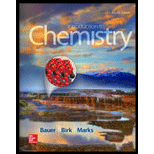
(a)
Interpretation:
The formula of ammonia is to be determined.
(a)
Explanation of Solution
Ammonia is a combination of nitrogen and hydrogen in which a covalent bond is formed by sharing of electrons between nitrogen and hydrogen atoms to form a molecular compound. Therefore, the formula of ammonia is
(b)
Interpretation:
The formula of ammonium phosphate is to be determined.
(b)
Explanation of Solution
The symbol and charge of the elements are analyzed on the basis of their position in the periodic table. The ammonium ion carries a
(c)
Interpretation:
The formula of hydrochloric acid is to be determined.
(c)
Explanation of Solution
Hydrochloric acid contains hydrogen cation and chloride anion in which the hydrogen ion contains a
(d)
Interpretation:
The formula of potassium hydroxide is to be determined.
(d)
Explanation of Solution
The potassium ion carries a
(e)
Interpretation:
The formula of chromium(III) oxide.
(e)
Explanation of Solution
The name chromium(III) indicates that the chromium ion contains a
(f)
Interpretation:
The formula of magnesium nitrate is to be determined.
(f)
Explanation of Solution
The magnesium ion carries a
(g)
Interpretation:
The formula of manganese(IV) oxide.
(g)
Explanation of Solution
The name manganese (IV) indicates that the manganese ion contains a
(h)
Interpretation:
The formula of nitrogen dioxide is to be determined.
(h)
Explanation of Solution
In nitrogen dioxide, the first word indicates that nitrogen is the first element and its symbol is written first, and the second word indicates that dioxide is the second element which takes the subscript two when writing the formula of the molecular compound. Therefore, the formula for nitrogen dioxide is
Want to see more full solutions like this?
Chapter 3 Solutions
Introduction to Chemistry